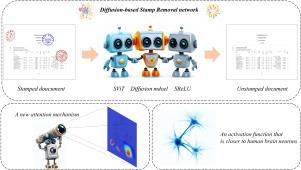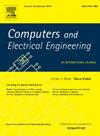An enhanced diffusion-based network for efficient stamp removal
IF 4
3区 计算机科学
Q1 COMPUTER SCIENCE, HARDWARE & ARCHITECTURE
引用次数: 0
Abstract
Current diffusion models excel in computer vision tasks, but stamp removal from documents remains challenging, especially when stamps are light-colored and blend with text. Existing methods struggle to preserve background text and rely heavily on the training set, excelling in either text or table stamp removal, but not both. To address these problems, we propose an enhanced diffusion-based stamp removal model using a Spatial Attention Mechanism and a Simulate Rectified Linear Unit. Spatial Attention Mechanism combines the spatial transformation capabilities of the Spatial Transformer Network with the feature extraction of the Convolutional Block Attention Module for higher-quality images. Simulate Rectified Linear Unit mimics neuronal signal transmission in the human brain, enhancing feature extraction. Our diffusion model achieved a PSNR of 44.7, SSIM of 0.99, and RMSE of 3.47 on the stamp dataset, and performed optimally on the denoising-dirty-documents, CLWD, and DIBCO 2017 datasets. It also attained the highest PSNR of 26.8 on the DIBCO 2013 dataset, with other metrics close to the best. Code is available at https://github.com/GuohaoCui/DiffusionModel.

基于扩散的增强型网络可高效清除印章
当前的扩散模型在计算机视觉任务中表现出色,但从文件中去除印章仍是一项挑战,尤其是当印章颜色较浅并与文本混合时。现有的方法难以保留背景文本,而且严重依赖训练集,在文本或表格图章去除方面表现出色,但无法同时去除两者。为了解决这些问题,我们提出了一种基于扩散的增强型图章去除模型,该模型采用了空间注意机制和模拟整流线性单元。空间注意机制结合了空间变换器网络的空间变换功能和卷积块注意模块的特征提取功能,可获得更高质量的图像。模拟整流线性单元模拟人脑中的神经元信号传输,增强了特征提取能力。我们的扩散模型在邮票数据集上的 PSNR 为 44.7,SSIM 为 0.99,RMSE 为 3.47,在去噪-脏文档、CLWD 和 DIBCO 2017 数据集上的表现最佳。它在 DIBCO 2013 数据集上的 PSNR 也达到了最高的 26.8,其他指标也接近最佳。代码见 https://github.com/GuohaoCui/DiffusionModel。
本文章由计算机程序翻译,如有差异,请以英文原文为准。
求助全文
约1分钟内获得全文
求助全文
来源期刊

Computers & Electrical Engineering
工程技术-工程:电子与电气
CiteScore
9.20
自引率
7.00%
发文量
661
审稿时长
47 days
期刊介绍:
The impact of computers has nowhere been more revolutionary than in electrical engineering. The design, analysis, and operation of electrical and electronic systems are now dominated by computers, a transformation that has been motivated by the natural ease of interface between computers and electrical systems, and the promise of spectacular improvements in speed and efficiency.
Published since 1973, Computers & Electrical Engineering provides rapid publication of topical research into the integration of computer technology and computational techniques with electrical and electronic systems. The journal publishes papers featuring novel implementations of computers and computational techniques in areas like signal and image processing, high-performance computing, parallel processing, and communications. Special attention will be paid to papers describing innovative architectures, algorithms, and software tools.
 求助内容:
求助内容: 应助结果提醒方式:
应助结果提醒方式:


